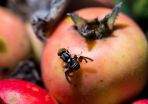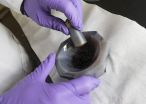Satellite animation shows System 91L developing in the Gulf of Mexico
2015-06-15
(Press-News.org) The National Hurricane Center is keeping a close eye on a developing tropical low pressure area in the south-central Gulf of Mexico. NOAA's GOES-East satellite provided imagery of the system, and an animation was created at NASA showing the development over two days. The system has a high chance for development into a tropical depression.
NOAA's GOES-East satellite sits in a fixed location providing continuous coverage of weather systems in the eastern U.S. and Atlantic Ocean basin. An animation of visible and infrared imagery of the low was created by NASA/NOAA's GOES Project at NASA's Goddard Space Flight Center in Greenbelt, Maryland. The animation shows the low developing near Mexico's Yucatan Peninsula on June 13 and moving north into the Gulf of Mexico where it began to consolidate. The spin of the low pressure area became evident as the low moved off the Yucatan.
At 8 a.m. EDT on Monday, June 15 The National Hurricane Center (NHC) noted that the thunderstorm activity associated with System 91L have become a little more concentrated. NHC said, "The low continues to produce tropical-storm-force winds well to the east and northeast of the center. Upper-level winds are forecast to become more favorable for development while this system moves northwestward across the western Gulf of Mexico, and a tropical depression or tropical storm could form at any time before the system reaches the Texas coast sometime tomorrow."
Regardless of further development the National Hurricane Center cautioned residents along the northwestern Gulf of Mexico. NHC said tropical storm conditions are possible along portions of the middle and upper Texas coast and the western Louisiana coast Monday night, June 15 and Tuesday, June 16. The system is also likely to bring heavy rainfall with possible flooding across portions of eastern Texas and western Louisiana.
INFORMATION:
[Attachments] See images for this press release:


ELSE PRESS RELEASES FROM THIS DATE:
2015-06-15
An international research team has found a way of protecting sensitive catalysts from oxygen-caused damage. In the future, this could facilitate the creation of hydrogen fuel cells with molecular catalysts or with biomolecules such as the hydrogenase enzyme. To date, this could only be accomplished using the rare and expensive precious metal platinum. Together with their French colleagues, researchers from Bochum and Mülheim describe the way in which a hydrogel can serve as a "protective shield" for biomolecules by two articles written in the journals Angewandte Chemie ...
2015-06-15
The stress and worry of giving birth prematurely does not adversely affect a mother's parenting behaviour, according to researchers at the University of Warwick.
Preterm children often require special care in the neonatal period including incubator care or assistance with breathing. Previous research has suggested that this stress, separation and an increased tendency for depression may impair a mother's parenting behaviour and adversely affect preterm childrens' long term development.
However, a new paper from the University of Warwick shows that mothers of preterm ...
2015-06-15
WASHINGTON, June 15, 2015 -- It's been around for decades and it's probably in your diet soda - for a little while longer anyway. PepsiCo announced recently it was removing the artificial sweetener aspartame from its Diet Pepsi products in the U.S. starting in August. The company cited consumer concerns about the chemical's safety. So this week, Reactions answers the question, "Is aspartame safe?" Check it out here: https://youtu.be/92r1oOul0kM.
INFORMATION:Subscribe to the series at http://bit.ly/ACSReactions, and follow us on Twitter @ACSreactions to be the first to ...
2015-06-15
HOUSTON -- (June 15, 2015) -- A team of biologists from Rice University, the University of Notre Dame and three other schools has discovered that an agricultural pest that began plaguing U.S. apple growers in the 1850s likely did so after undergoing extensive and genome-wide changes in a single generation.
This new result, which appears online this week in Ecology Letters, came from applying the latest tools of genome sequencing and analysis to preserved evidence from experiments carried out at Notre Dame in the 1990s. The research focuses on the fruit fly Rhagoletis ...
2015-06-15
DENVER, June 15 -- A new study from the University of Colorado Denver finds that scientists agree that children of same-sex parents experience 'no difference' on a range of social and behavioral outcomes compared to children of heterosexual or single parents.
The study was led by Jimi Adams, an associate professor in the Department of Health and Behavioral Studies at CU Denver College of Liberal Arts and Sciences, and published this month in Social Science Research.
The research comes at a time when the U.S. Supreme Court is determining whether the Constitution requires ...
2015-06-15
Bethesda, MD (June 15, 2015) -- Modifying the small white blood cells that protect against disease might help treat immune disorders, according to a study1 published in Cellular and Molecular Gastroenterology and Hepatology, the basic science journal of the American Gastroenterological Association. Specifically, researchers found that modulation of B lymphocyte function may be a means of regulating T lymphocyte function to treat immune-mediated disorders, including inflammatory bowel diseases (IBD).
Researchers uncovered the following pathway: gut bacteria stimulate intestinal ...
2015-06-15
This news release is available in German. An innovative mechanism that the innate immune system uses to control viral infections has been uncovered by researchers at the University Medical Centers in Mainz and Freiburg. Central to this is the discovery that two different but related elements of the immune system can act together in concert to fight, for example, rotavirus infections. Infection with rotavirus is the most common cause of diarrhea in children around the world. The results of the research have recently been published in the eminent scientific journal Nature ...
2015-06-15
GAINESVILLE, Fla. -- Aging can cause many changes to the body, including obesity and a loss of lean mass. Now, a group of University of Florida Health researchers has discovered that an existing drug reduces body fat and appetite in older rats, which has intriguing implications for aging humans.
Rapamycin, a pharmaceutical used to coat coronary stents and prevent transplant rejection, reduces obesity and preserves lean body mass when given intermittently to older rats. The two rapamycin-related studies were published recently in the Journal of Gerontology as a joint effort ...
2015-06-15
A simple way to turn carbon nanotubes into valuable graphene nanoribbons may be to grind them, according to research led by Rice University.
The trick, said Rice materials scientist Pulickel Ajayan, is to mix two types of chemically modified nanotubes. When they come into contact during grinding, they react and unzip, a process that until now has depended largely on reactions in harsh chemical solutions.
The research by Ajayan and his international collaborators appears in Nature Communications.
To be clear, Ajayan said, the new process is still a chemical reaction ...
2015-06-15
The city where an individual lives can influence the risk of dying by suicide, according to a new study from sociologists at Rice University and the University of Colorado at Boulder.
"Suicide in the City: Do Characteristics of Place Really Influence Risk?" appears in the latest edition of Social Science Quarterly. The study found that adults living in cities with more socio-economic disadvantages and fewer families living together have higher odds of suicidal death than adults living in less-disadvantaged cities and cities with more families living together.
The findings ...
LAST 30 PRESS RELEASES:
[Press-News.org] Satellite animation shows System 91L developing in the Gulf of Mexico




